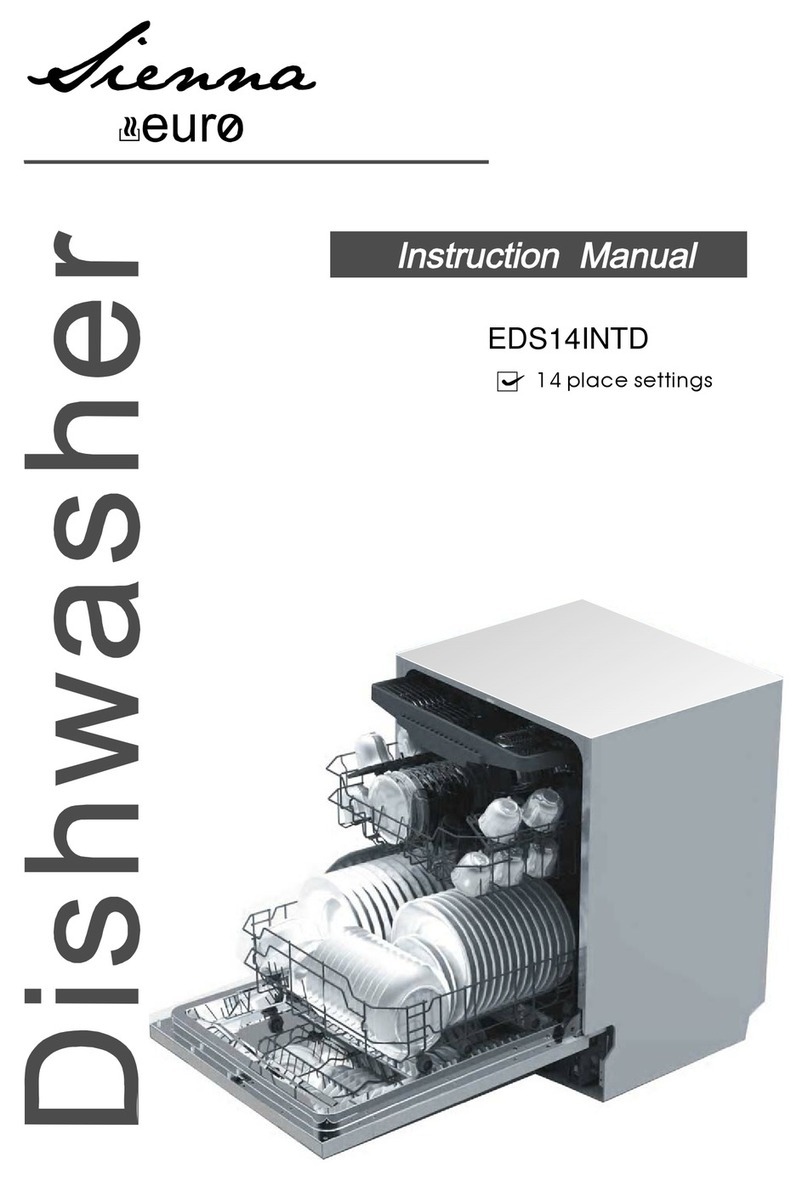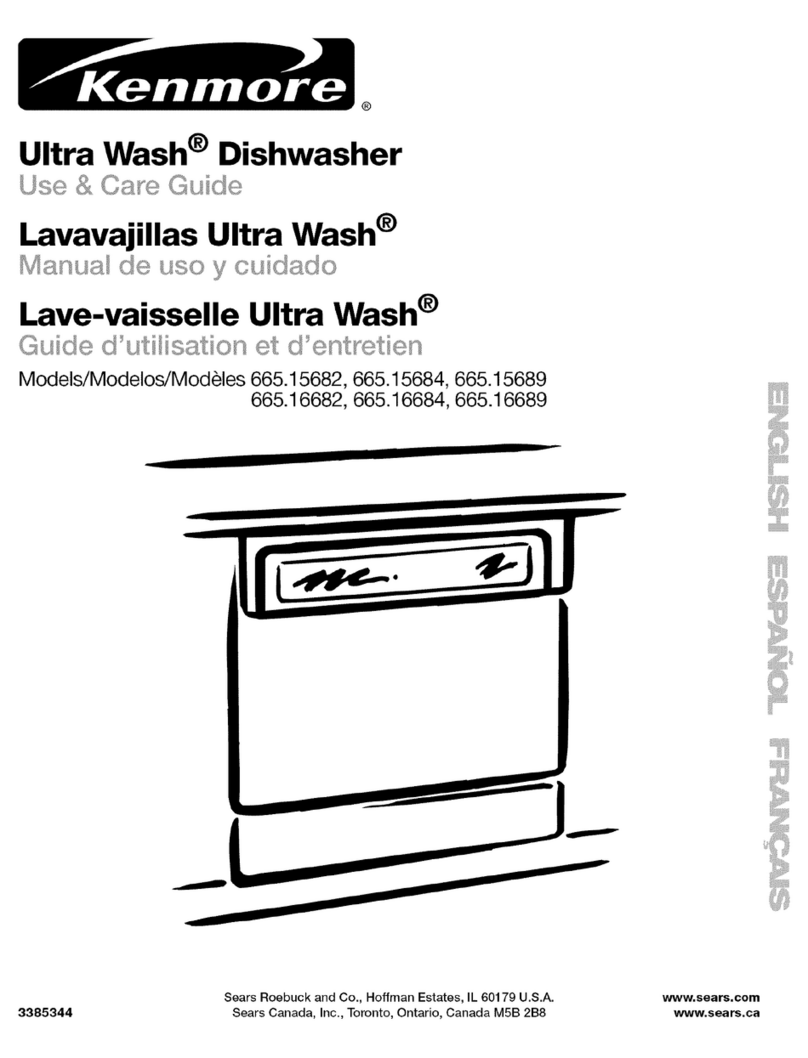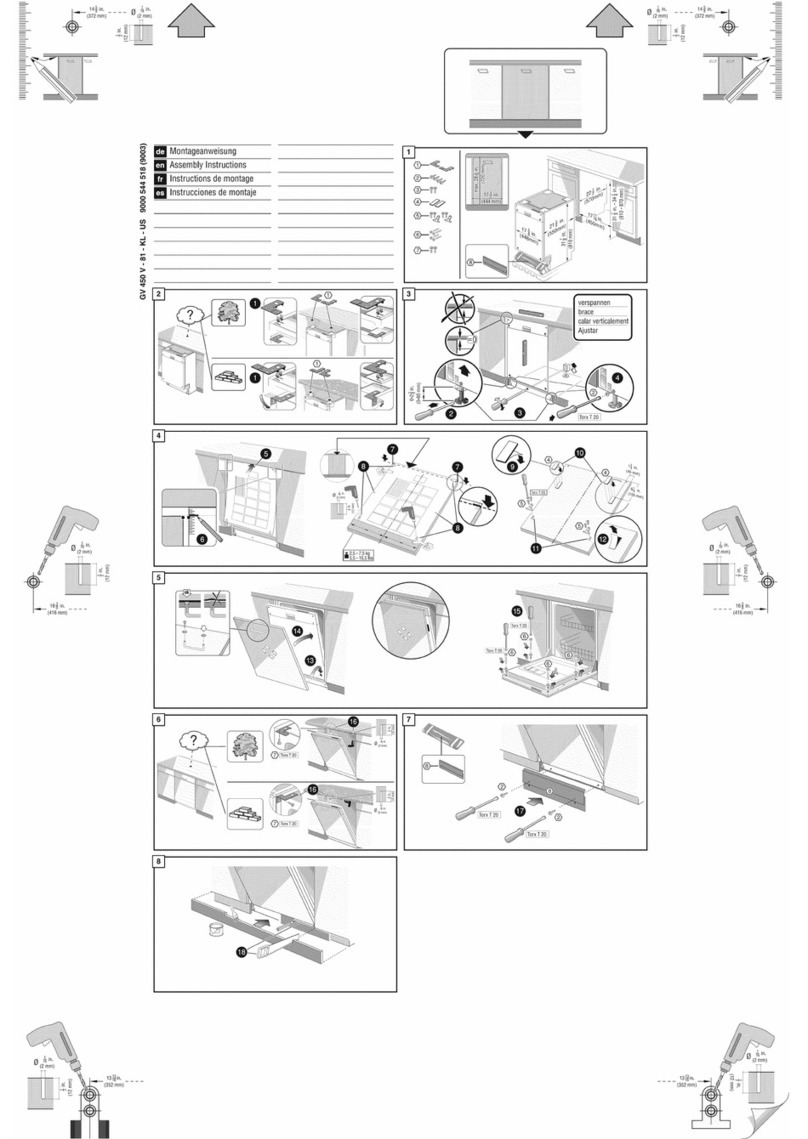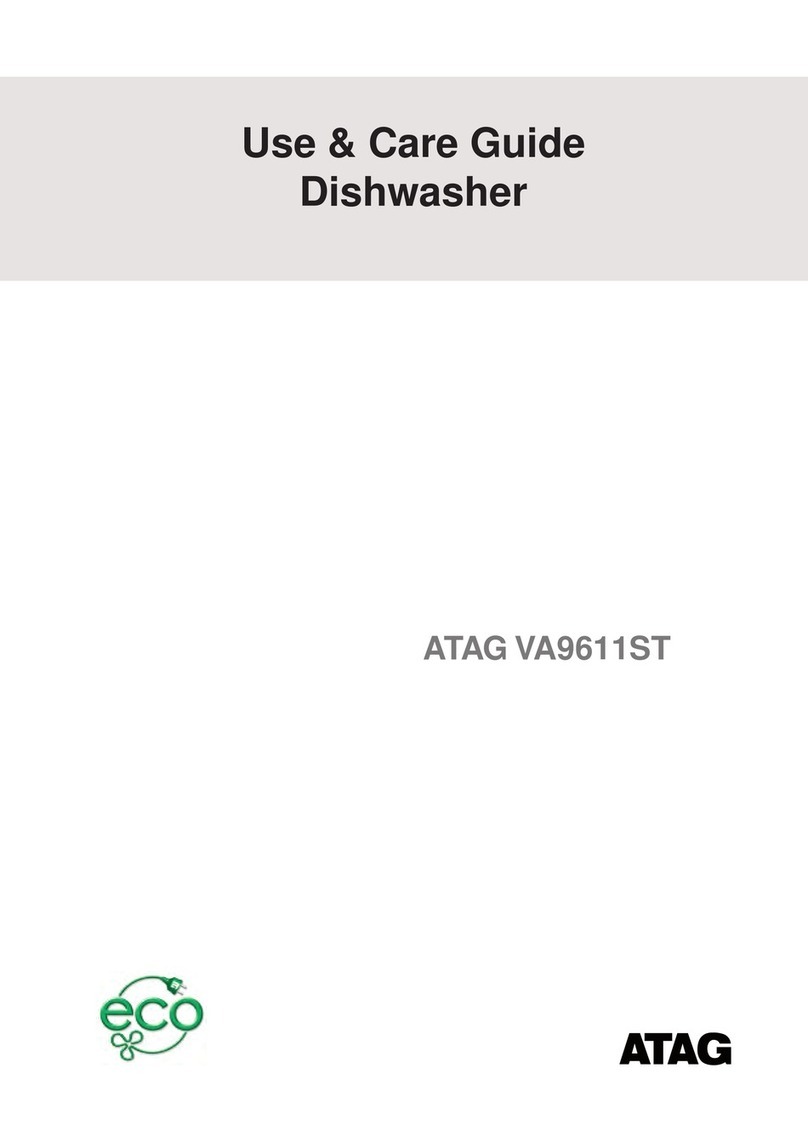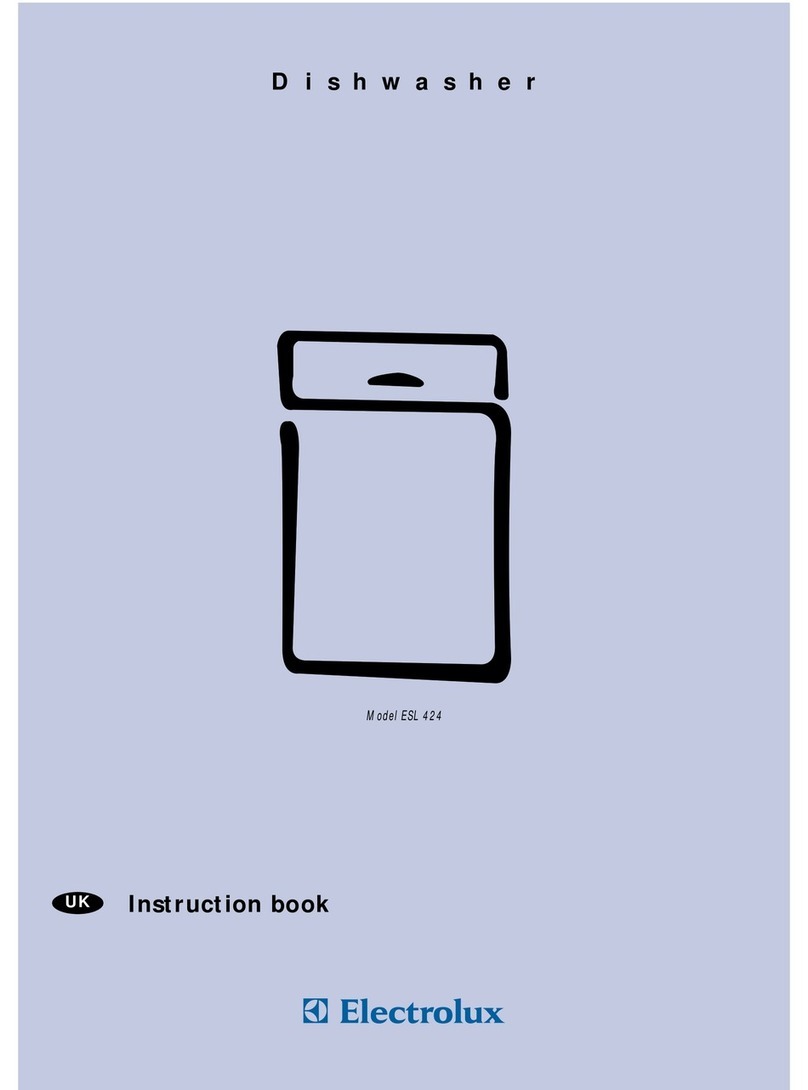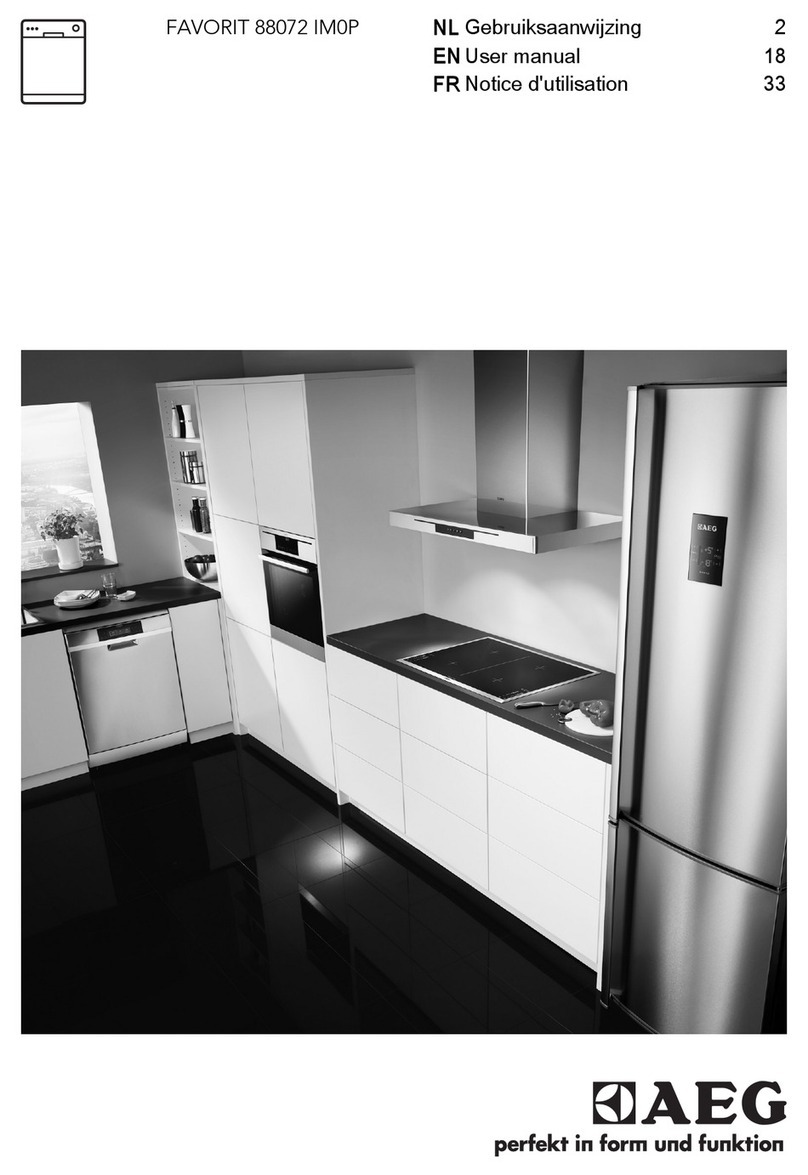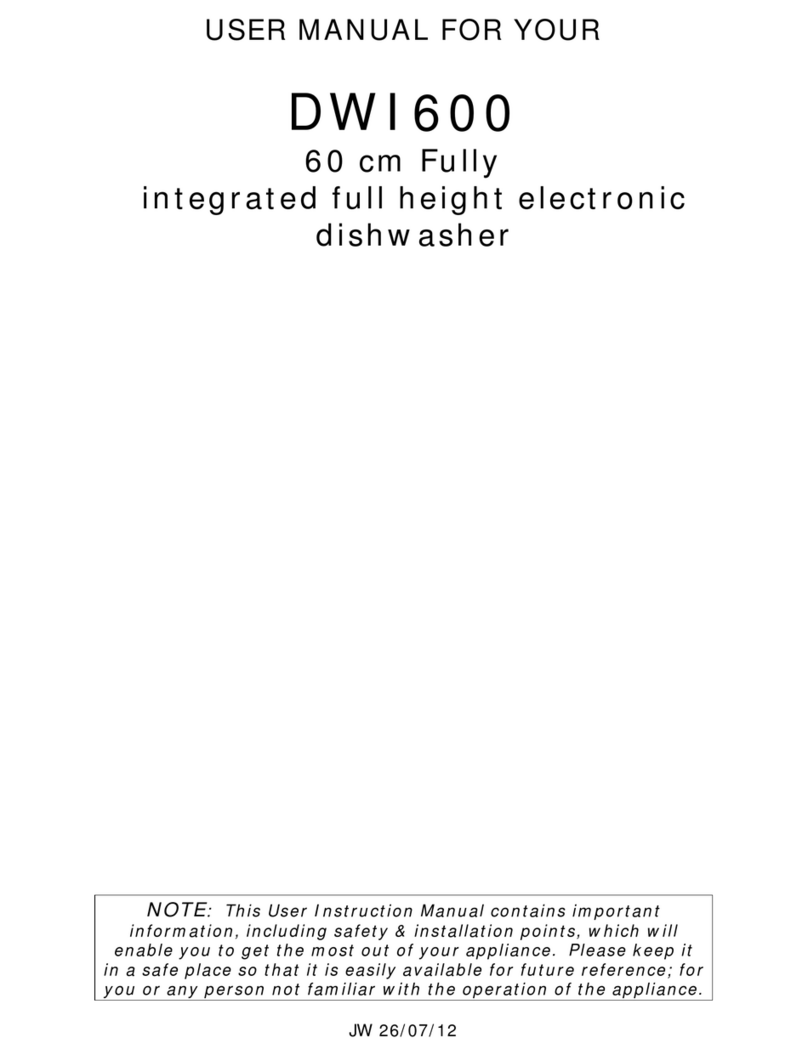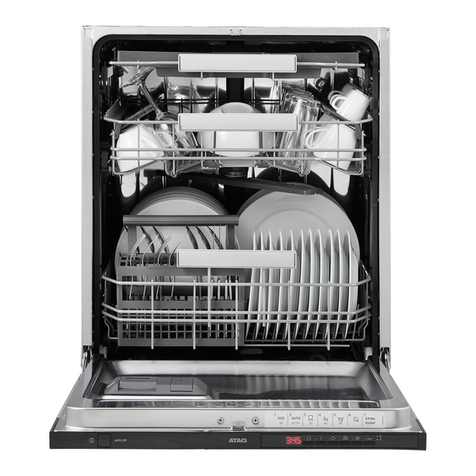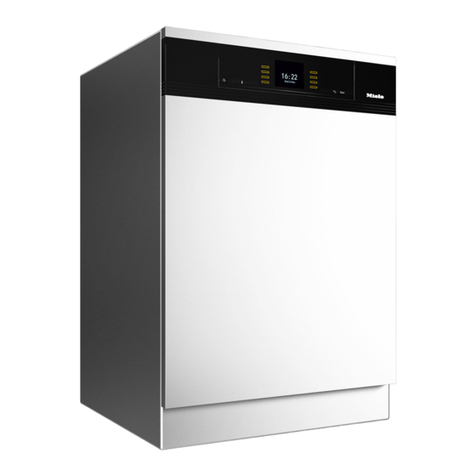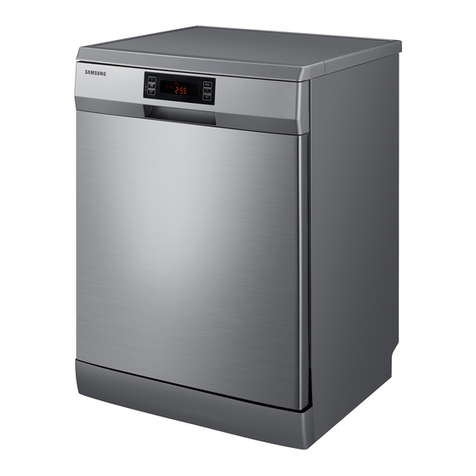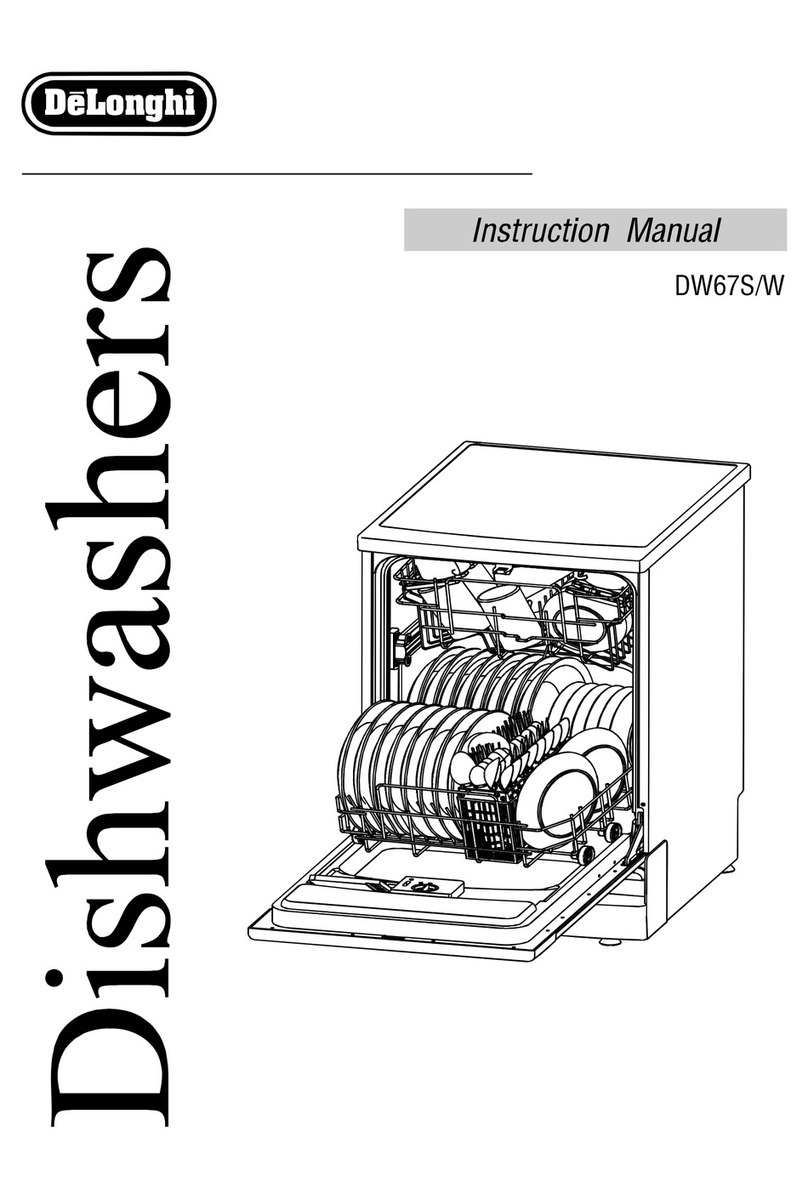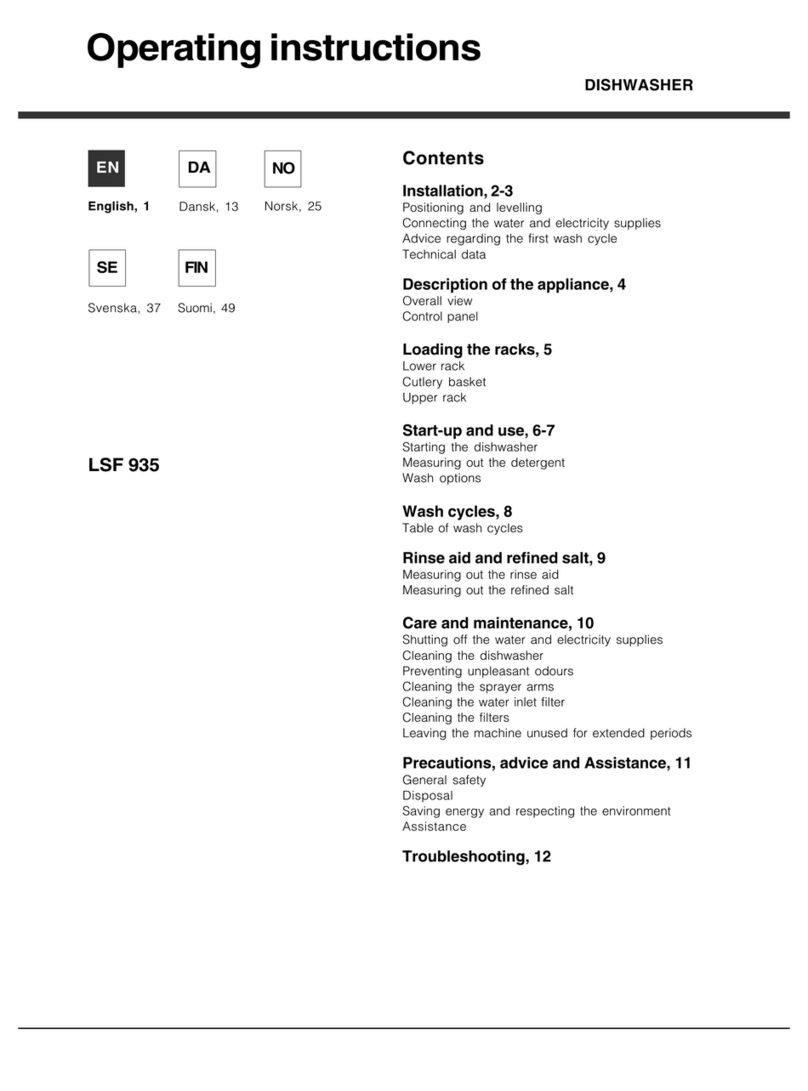Sienna EDS14SX User manual

EDS14SX
14 place settings
Alt function
Auto program

Witheachwashcycle.
Compartment
For programmes with pre-wash only.
(Follow the !)User Manual
Electric indicator on control panel (if provided).
Check the rinse aid level
Load the baskets
Select a programme
Turn on the water tap and press the . The machine will start working
after about 10 seconds.
Start/Pause Button
Running the dishwasher
Switch off the appliance
Turn off the water tap,
unload the baskets
Fill the detergent dispenser
Warning: wait a few minutes (about 15 minutes) before unloading the dishwasher to avoid handling
the dishes and utensils while they are still hot and more susceptible to break.
They will alsodry better.Unload the appliance, startingfrom the lower basket.
Changing theprogramme
Add forgotten dishes in the
dishwasher.
Scrape off any large amount of leftover food. Soften remnants of burnt food in pans,
then load the baskets. Refer to the dishwasher loading instructions.
Close the door,press the Programme Button until the selected programme lights up.
( See the section entitled Operation instruction )“”
When the working cycle has finished, the buzzer of the
dishwasher will sound 8 times, then stop.
Turn off the appliance using the On/Off Button.
If the appliance is switched
off during a wash cycle.
Open the door carefully.
Hotsteam may escape
when thedoorisopened!
If the appliance is switched off during a wash cycle, when switched
on again, please re-select the washing cycle and operate the dishwasher
according to the original Power-on state.
Switch on the appliance Press the On/Off button to switch on the appliance, Open the door.
For detailed operating method read the corresponding content onthe instruction manual.
1. Arunning cycle can only be modified if it has been running for a short time. Otherwise the detergent
may have already been released and the water already drained. If this is the case, the detergent
dispenser must be refilled.
2.
Press the Start/Pause button, press the program button for more than three seconds,the
machine will be in standby state, then you can change the program to the desired cycle setting
1.Press the Start/Pause Button to stop the washing.
2.Open the door a little .
3.After the spray arms stop working, you can open the door
completely.
4.Add forgotten dishes.
5.Close the door.
6.Press the Start/Pause Button, the dishwasher will run
after 10 seconds.

To review the section on troubleshooting Tips
willhelp youto solve some common problems
by yourself .
Dear Customer,
Please carefully readthismanualbefore usingthe
dishwasher, itwill help you touseand maintainthe
dishwasher properly.
Pass it on to anysubsequent owner of the appliance.
Thismanualcontains sections on safety Instructions,
Operating Instructions, InstallationInstructions and
Troubleshooting Tips, etc.
The manufacturer, following a policy of constant
developmentand updating of the product, may
make modifications withoutgiving prior notice.
Keep it as arefer in the later days.
If you can not solvethe problems byyourself ,
please ask for the help of professional technicians.
This appliance is intended to be used in household
andsimilarapplications suchas:
-staff kitchen areas in shops,offices and other
working environments;
-farm houses;
-byclients inhotels,motels and otherresidential
type environments;
-bed and breakfast type environments.
Dishwasher Features.................................... ...2
AttentionbeforeorafterloadingtheDishwasher
Baskets..........................................................6
Filtering System.............................................10
Caring for the Dishwasher..................... .........11.
A Fill the RinseAid Dispenser............. .. ..3、..... ...
B Function of Detergent .........................4、........
..............7
The Method Loading Normal Dishware
Wash Cycle Table...........................................8
Turning on theAppliance................................8
Change theProgramme.............. ................9....
At the end of the Wash Cycle...........................9
PositioningtheAppliance................... ..........12..
Water Connection.................................. .......13.
AboutPowerConnection........................ .......12.
Startof dishwasher................................ ......14..
Before calling for service........................... .....15.
Errorcodes.................................... ..............16.
Technical information.............................. .....17..
Control Panel...................................................2

This appliance must be grounded. In the event of a
malfunction or breakdown, grounding will reduce
the risk of anelectric shock by providing a path of
least resistance of electric current. This appliance
is equipped with a cord having an equipment-
grounding conductor and a grounding plug.
The plug must be plugged into an appropriate outlet
that is installed and grounded in accordance with
all local codes and ordinances.
Keep children away from detergent and rinse aid, keep
child away from the open door of the dishwasher,
there could still be some detergent left inside.
ren
Donotabuse,siton,orstandonthedoorordish
rack of the dishwasher.
Do not touch the heating element during or
immediately after use.
(This instruction is only applicable to machines
with a visual heating element.)
Do not wash plastic items unless they are marked
dishwasher safe or the equivalent. For plastic items
not so marked, check the manufacturer's
recommendations.
Use only detergent and rinse additives
designed for an automatic dishwasher.
Never use soap, laundry detergent, or hand
washing detergent in your dishwasher. Keep
these products out of the reach of children.
During installation, the power supply must not
be excessively or dangerously bent or flattened.
Do not tamper with controls.
Do not place any heavy objects the
door when it is open. The appliance could tip
forward.
on or stand on
When loading items to be washed:
1) Locate sharp items so that they are not likely
to damage the door seal;
2 Warning: Knives and other utensils with
sharp points must be loadedinthe basket
with their pointsdown or placed in a
horizontalposition.
)
When using your dishwasher, youshould
prevent plastic items from coming into contact
with the heating element.(This instruction is only
applicable to machines with a visual heating
element.)
Ifthesupplycord isdamaged, itmust bereplaced
bythemanufactureroritsserviceagentora
similarly qualified person in order to avoid a
hazard.
Pleasedispose ofpackingmaterials properly.
Use the dishwasher only for its intended function.
Remove the door to the washing compartment when
removing an old dishwasher from service or discarding it.
Dishwasher detergents are strongly alkaline, they
can be extremely dangerous if swallowed.Avoid
contact with skin and eyes and keep children away
from the dishwasher when the door is open.
Check that the detergent comparment isempty
after completion of the wash cycle.
Theappliance is to be connectedto the water
mainsusingnewhose setsand thatold hose-sets
should not be reused.
The maximum number of place settings to be
washedis 14.
The maximum permissible inlet water pressure is
1Mpa.
The minimum permissible inlet water pressure is
0.04Mpa.
Children should be supervised to ensure that they do
not play with the appliance.
This appliance is not intended for use by persons
(including children with reduced physical, sensory or
mental capabilities, or lack of experience and
knowledge ,unless they have been given supervision
or instruction concerning use of the appliance by a
person responsible for their safety.
)
When using your dishwasher, follow the precautions listed below:
The door should not be left open,
since this could increasethe risk of tripping.
Improper connection of the equipment-grounding
conductor can result in the risk of an electric shock.
Check with a qualified electrician or service
representative if you are in doubt whether the
appliance is properly grounded. Do not modify the
plug provided with the appliance; If it does not fit
the outlet. Have a proper outlet installed by a
qualified electrician.
Do not operate your dishwasher unless all
enclosure panels are properly in place. Open
the door very carefully if the dishwasher is
operating, there is a risk of water squirting out.
The dishwasher must always be connected to
the water system using new hose sets.
If theappliance is installedon a carpetfloor,
take care that the openings in its base are not obstructed.

beforeusingit for the firsttime.
To get the best performance from yourdishwasher,read all operating instructions
10 11
Back View
1
2
3
4
5
6
7
89
Front view
Lower basket
Dispenser
Cupshelf
Spray arms
Filter assembly
Inletpipeconnector
Drain pipe
Upperbasket
Cutlery rack
Topspray arm
1
Inner pipe
5
6
7
8
9
11
10
3
24
1. On/OffButton: To turn on/off the power supply.
3. Program indicators.
2.Program Button:Press thebutton toselect
appropriate Program.
. Start /Pause Button: To start the selected washing
program or pause the washing program when the
machine is working.
8
7.Extra Dryingfunctionselect Button:To selectExtra
Dryingfunction.(
)
This function can only beused with
programmes Intensive,Heavy, Normal, Glass and
1Hour
4. Delay Button: Press the button to delay.
5. Dual zonewashfunction, press the button
toselecteitherupper basket or lower basketloaded,
and the response indicator.
Alt Button:
6. Child lock function: press Delay Button and Alt Button
simultaneously for more than 3 seconds to lock the
program, use the same method to cancel the child lock
function.
9.Display screen:to show the reminding time
andthe state(running state, delay time etc ).
RinseAid indicator:
Indicates when the dispenserneeds to be refilled.
Delay time ,Remain time ,or error codes indicator:
10.Indicators:
Alt function indicator:
ExtraDryingindicator:
Child lockindicator:
Extra drying:An increased temperature during the final
rinse to increase drying well. There is a slight increase
in the energy consumption.

Before using your dishwasher for the first time:
A. Filltherinse aiddispenser
B. Fill in detergent
Therinse aid isreleasedduringthe finalrinse to prevent water from forming dropletsonyour dishes, which can
leave spots and streaks. It also improvesdryingby allowing water to rolloff thedishes. Yourdishwasheris
designedto use liquidrinseaids.The rinseaid dispenser islocatedinsidethe door next to thedetergent dispenser.
To fillthe dispenser, open the capand pour the rinse aidinto thedispenser untilthe level indicator turns completely
black.Thevolume ofthe rinseaid containeris about 110ml.
RinseAid Dispenser
Function of RinseAid
Rinse aid is automatically added during the last rinse, ensuring thoroughrinsing, and spot and streakfree drying.
Attention!
Onlyuse branded rinse aid for dishwasher. Never fill the rinse aiddispenserwith any other substances
(e.g. Dishwasher cleaning agent,liquid detergent). This would damage the appliance.
As the rinseaid diminishes, the size of the black dot
on the rinse aidlevel indicator changes, as illustrated below.
Full
3/4full
1/2full
1/4full-Shouldrefilltoeliminatespotting
Empty
If there is no rinse-aid warning light in the control panel, you can judge the amount of rinse-aid by the color of the
optical level indicator "C" located next to the cap. When the rinse-aid container is full, the whole indicator will be
dark .As the rinse-aid diminishes, the size of the dark dot decreases. You should never let the rinse aid get below
1/4full.
When to Refill the RinseAid Dispenser
RINSEAID DISPENSER
To open the dispenser,turn the cap to the "open" (left) arrow and lift it out.
Pour the rinse aid into the dispenser, being careful not to overfill.
Replace the capby inserting it aligned with "open" arrow and turning ittothe closed(right) arrow.
Be carefulnot to overfillthe dispenser,because thiscould cause over sudsing. Wipe away anyspills
witha damp cloth. Don't forgetto replace thecap before you close the dishwasher door.
Attention!
Clean up any rinse aid spilt during fillingwith an absorbent cloth toavoid excess foaming
during the nextwash.
1
2
3
C(Rinse-Aidindicator)

Adjusting RinseAid Dispenser
The rinse aid dispenser has six or four settings.Always start with the dispenser
set on "4". If spots and poor drying are a problem,increase the amount of rinse
aiddispensedbyremoving thedispenser lidandrotatingthedialto"5". Ifthe
dishes still are not drying properly or are showingspots, adjust the dial to the next
higher lever until your dishes are spot-free. The recommended setting is "4".
(Factory value is "4".)
Increase the dose if there are drops of wateror limespots on the dishes after washing.
Reduce itif there are sticky whitish stains on your dishesor abluish film on glassware or
knifeblades.
Detergentswith its chemical ingredients are necessary toremove dirt,crushdirt and transport it out of the dishwasher.
Most of the commercial quality detergentsare suitablefor thispurpose.
Detergents
There are 3 sorts of detergents
1.With phosphate and withchlorine
2.With phosphate and withoutchlorine
3.Without phosphate and without chlorine
Based on their chemicalcomposition, detergentscan be split in two basic types:
Theuseof normal washing programs in combination with concentrated detergents
reducespollutionand is goodforyourdishes; these washprogramsare specificallymatched
to the dirt-dissolving properties of the enzymes of theconcentrated detergent. For this reason
normal washprograms in which concentrated detergents are used canachieve the same
results that can otherwise only be achieved using intensive programs.
“”
“”
“”
Detergent tablets ofdifferent brands dissolve at different speeds. For this reason some
detergent tablets cannot dissolve anddevelop their full cleaning power during short
programs. Therefore please use long programs when using detergent tablets, to
ensurethe completeremovalof detergentresiduals.
The dispenser must be refilled before thestart of each wash cycle followingthe instructions
provided in the washcycle table .Your dishwasher uses less detergent andrinse aid than
Conventional dishwasher. Generally,onlyone tablespoon of detergent is needed for
a normal wash load.Moreheavilysoileditemsneed more detergent.Alwaysaddthe
detergent just before starting thedishwasher, otherwise it could get damp and will not
dissolve properly.
Concentrated Detergent
DetergentTablets
DetergentDispenser
conventional,alkaline detergents with caustic components
low alkalineconcentrated detergents with natural enzymes
Normally new pulveriseddetergent is withoutphosphate. Thus the water softener function of
phosphate is not given. In this case we recommend tofill salt in the salt container even when
thehardness ofwater isonly6 dH. Ifdetergents without phosphate are used inthe case ofhardwater
often white spots appearon dishes and glasses. In this case please add more detergentto reach
better results. Detergents without chlorine doonlybleacha little. Strong and coloured spots will not
be removedcompletely.Inthiscase please choose a programwitha higher temperature.
°

Amount ofDetergenttoUse
ProperUseofDetergent
Use only detergent specifically madeforthe use in dishwashers. Keep your detergent fresh and dry.
Don't put powdereddetergent into the dispenser untilyou're ready to wash dishes.
Dishwasher detergent is corrosive! Take care tokeep itoutofreach of children.
Always add the detergent just before starting eachwash cycle.
Only use branded detergent aid for dishwasher.
If the lid is closed: press release button.The lid will spring open.
Detergent tablet
Detergent powder
Fill the detergentdispenser with detergent.
Themarkingindicatesthedosinglevels ,as
illustratedontheright:
The place for main wash cycle detergent.
The placefor pre -wash cycle detergent.
Please observe the manufacturersdosing andstorage
Recommendations as stated on the detergent packaging.
Close thelidand press until itlocks inplace.
Ifthedishesare heavily soiled, placean additional
detergent dose in the pre-wash detergent chamber. This detergent will takeeffect during the pre-wash phase.
A
B
Fill in Detergent
You find information about the amountof detergent for the single programme on the last page.
Pleasebe aware,thataccording to the level soiling and the specific hardnessof water differences are possible.
Pleaseobserve the manufacturer'srecommendations on the detergent packaging.

Cutlery with wooden,horn china or
mother-of-pearl handles
Plasticitems that are not heat resistant
Older cutlerywith glued parts that are not
temperatureresistant
Bonded cutlery items or dishes
Pewter or cooper items
Crystal glass
Steel items subject to rusting
Wooden platters
Items made fromsynthetic fibres
Some types of glassescan become
dull after a large number of washes
Silver and aluminum parts have a
tendencyto discolourduring washing
Glazed patterns may fade if machine
washed frequently
Are not suitable Are oflimited suitability
Dishesand itemsof cutlery mustnot lie insideoneanother, orcover each other.
To avoid damage to glasses, theymust not touch.
Load large itemswhich are most difficult to clean into the lower basket.
The upper basket is designed to hold moredelicate and lighter dishware such as glasses, coffee
andteacups
Long bladed knives stored in an uprightpositionare a potential hazard!
Long and/or sharp items of cutlery such as carving knives must be positioned
horizontallyin the upperbasket.
Please do not overload your dishwasher. This is important forgood results and for
reasonable consumption of energy.
Load hollow items suchas cups, glasses, pans etc. With the opening facing downwardsso that
water cannot collect in the container or a deep base.
Consider buyingutensilswhich are identifiedas dishwasher-proof.
Usea mild detergentthatisdescribed as'kind todishes'. Ifnecessary,seek further
information fromthe detergent manufacturers.
Forparticular items,select aprogramwithas low a temperature aspossible.
To prevent damage, do not take glassand cutlery out of the dishwasher immediately
after the programme has ended.
(For best performance of the dishwasher, follow these loading guidelines.
Features and appearance of baskets and cutlerybasketsmay vary from your model.)
Scrape off any largeamounts ofleftover food. Soften remnants of burnt food in pans.
It is not necessary to rinse the dishes under running water.
Place objects in the dishwasher in the following way:
1.Items such as cups, glasses, pots/pans, etc. are faced downwards.
2.Curved items, or ones with recesses, should be loaded aslant so that water can run off.
3.All utensils are stacked securely and can not tipover.
4.All utensils are placed in the way that the spray arms can rotatefreely during washing.
Very small items should not be washed in the dishwasher as they could easily fall out of the basket.
To prevent water drippingfrom the upper basket into the lower basket, we recommend thatyou
empty the lower basket first and then the upper basket.

Theupper basket is designed to hold more delicate
and lighter dishware such as glasses, coffee and
teacups and saucers, aswell asplates,small bowls
andshallowpans (as long astheyare not toodirty).
Position thedishes andcookwaresothatthey will
notgetmovedbythespray ofwater.
We suggest that you place large items and the most
difficultto cleanitemsare to be placedintothelower
basket: suchas pots, pans, lids, serving dishes and
bowls, as shown in the figure below. It is preferable to
place serving dishes and lids on the side of the racks
in order to avoid blocking the rotation of the top spray
arm.
Pots,servingbowls,etc,mustalwaysbeplacedtopdown.
Deep pots should be slanted to allow water to flow out.
Please bereminded that:
The Bottom Basket features folding spikes so that largeror more pots and pans can be loaded.
Folding Spikes of Lower Basket
Forbetter stacking of pots and pans,
the spikescan be folded down as
show in the picture right.
Folding back the cup shelives
For better stacking of pots and pans,
the spikes can be folded down as
show in the picture right.
Cutleryshouldbe placed inthecutlery rackseparately
from each other in the appropriate positions, and do
make sure theutensils do not nest together,this may
causebadperformance.
Adjusting the Upper Basket
Theheightof theupperbasketcanbeadjustedinorderto
create morespace for largeutensilsbothfor the upper
/lowerbasket.The height of theupper basket canbe
adjusted by lift up the basket for the upper position, and up
press the handle to lower the upper basket, see the picture
below:

Pre-wash(45 )
Wash (55 )
Rinse
Rinse(60 )
Drying
℃
℃
℃
Means:need to fill rinse into the Rinse-Aid Dispenser.
()
Forheavilysoiledloads,
such as pots,plates, glasses
and lightly soiled pans.
* : This programis the test cycle.Theinformationfor comparabilitytest
in accordance with , as follows:
AS/NZS 2007.1
AS/NZS 2007.1
Capacity: 14setting
Position Upper basket: upper wheels on rails
Rinse aid setting: 6
Open the door slightly 50mm to assist indrying of the dishes after every wash
Means:need to fill rinse into the Rinse-Aid Dispenser.
()
Intensive
Normal
Rapid
Wash (40 )
Rinse
Rinse(45 )
℃
℃
180
165
150
40
1.15
0.74
1.40
0.50
16.5
13.0
12.6
10.0
1Hour
60 9.0
0.80
20g
Standard daily cycle for
normallysoiledloads, such
aspots plates glasses.、、
Forheaviestsoiledcrockery,
and soiled pots pans
dishesetc withdried
on soiling.
、、
Ashorter washfor lightly
soiled loads that do not
needdrying.
For lightly soiled loads that
do not need excellent drying
efficiency.
Glass
Pre-wash
wash(40 )
Rinse
Rinse(60 )
Drying
℃
℃
120
0.85
13.0
Forlightly soiledcrockery
andglass.
Torinse dishes that youplan
to wash later that day.
Pre-wash
8 0.01 3.5
Startinga cycle wash
1 Draw out the lowerand upper basket, load the dishes and pushthem back.
Itis to load the lower basket first,thenthe upper one (see the section entitled
Loading the Dishwasher ).
2 Pour in the detergent (see the section entitled Detergent and Rinse Aid ).
3 Insert the plug into the socket. The power supplyis 220-240 VAC /50 HZ, the specification
of the socket is 10A 250VAC. Makesure that the water supply is turned on to full pressure.
4 Close the door, press the ON/OFF Button, and the display will turn on.
5 Press the program Button , the wash program will be changed asfollows direction:
“”
“”
Intensive->Heavy->Normal->Glass->1 Hour->Rapid->Soak;
If aprogram is selected, the response light will light. Then press the Start/Pause button, the
dishwasher begins to start.
recommended
Pre-wash(50 )
Wash (65 )
Rinse
Rinse
Rinse(65 )
Drying
℃
℃
℃
Pre-wash
Wash (45 )
Rinse
Rinse(50 )
Drying
℃
℃
Pre-wash(50 )
Wash(60 )
Rinse (50 )
Drying
℃
℃
℃
5/27.5g
5/27.5g
(OrAll )in1
5/27.5g
5
(Or All )
/27.5g
in1
5
(OrAll )
/27.5g
in1
Heavy
(*AS/NZS 2007.1)
Soak

Wash the arms in soapy and warmwater and use a softbrush to
clean thejets. Replace them afterrinsingthem thoroughly.
When following this procedure from step1 to step 3, the filter system will be removed;
when following it from Step 3 to Step 1, the filter system will be installed.
It is dangerous to open the door when washing, because the hot water may scald you.
When the working cycle has finished, the buzzer of the dishwasher will sound for 8 seconds, then stop. Turn off
the appliance using the Power switch button, shut off the water supply and open the door of the dishwasher.
Wait for afew minutes before unloading thedishwashertoavoidhandlingthe dishes and utensils while they
are still hot and more susceptible to breakage. They will also dry better.
Switch Off the Dishwasher
1.Switch off the dishwasher by pressing the button.
2.Turnoffthewater tap. Power
Open the door carefully.
Hot dishes are sensitive to knocks. The dishes should therefore be allowedto cool down around 15 minutes
before removing from the appliance.
Open the dishwasher door, leave it ajar and wait a fewminutes before removing the dishes. In this way they
will be cooler andthe drying will be improved.
Unloadingthedishwasher
It is normal that the dishwasher is wet inside.
Empty thelower basket first and thenthe upperone. This will avoid water dripping from the upper Basket onto
the dishes in the lower one.
If you openthe door , the machine will pause. The running indicator will
stop blinking and the buzzer will be every minute unless you close the door . After
you close the door ,the machinewillkeep on workingafter 10seconds.
during awash cycle
beeping
Premise:
Acycle that is underway can only be modified if it has only been running for a short time. Otherwise, the
detergent may havealready been released,and the appliancemay have already drained the wash water.
If this is the case, the detergent dispenser must be refilled (see the section entitled " Loading the
Detergent " ).
Press the Start/Pausebutton, the machinewill be in standby state, press the program button for more than
3 then you can change the program tothe desired cycle setting (see the section entitled " Starting
a wash cycle. . ." ).
1
2seconds
Aforgotten dish can be added any time before the detergent cup opens.
Add forgotten dishes.
Close the door
After the spray arms stop working,you can open the door
completely.
2
3
Open the door a little to stop the washing.
14
5
6
Press the Start/Pause button
Press the button, the dishwasher will run
after 10 seconds.
Start/Pause
When you presstheStart/Pausebutton topause during washing,the running indicator will
stop blinking and the dishwasher will every minuteunless you press the
button to start.Start/Pause be beeping

The filter preventslarger remnantsof food or other objects from getting inside thepump.
Theresidues may block thefilter, inthiscasethey must be removed.
The filter system consists of a coarse filter,a flat (Main filter)
And a microfilter(Fine filter).
Food and soil particles trapped inthis filter arepulverizedby a
special jet on the lower spray arm andwasheddown to drain.
Larger items, such as piecesof bones or glass, that could block
the drain Toremove
the itemsandeasily becometrapped inthecoursefilter
caughtbythe filter,gently squeeze the tap on thetopofthis
filterandliftout.
Thisfilter holds soil and food residuesin the sumpareaand
prevents it from being on thedishes during wash cycle.redeposited
Main filter
1
Coarse filter
2
Fine filter
3
2
3
1
Filterassembly
Thefilter efficiently
For best performance and results, the filter must be cleaned regularly. this reason, it isa goodidea to
remove thelarger foodparticlestrapped in the filter aftereach washcycle by rinsing the semicircular filterand
cup under running water. To remove the filter device, pull thecup handle in the upwarddirection.
removes food particles from the wash water, allowing it to be recycled during the cycle.
For
The dishwasher must never be used without the filters.
Improper replacementof the filter may reduce the performancelevel ofthe appliance
and damage dishesand utensils.
Step 1 Turn the filterin anti-clockwisedirection,:
Step 2 lift the filter up:
When following this procedure from step 1 to step 2, the filter system will be removed;
when following it from Step 2 to Step 1, the filter system will be installed.
1
2

The control panelcan be cleaned by using a lightly dampened cloth.
Aftercleaning, make sure to dry it thoroughly.
For the exterior, use agood appliance polish wax.
Never usesharp objects, scouring pads orharsh cleaners on any part of the dishwasher.
ProtectAgainst Freezing
1.Cut off the electrical power to the dishwasher.
2.Turn off the water supply and disconnect the water inlet pipe from the water valve.
3.Drain the water from the inlet pipe andwater valve. (Use a pan to gather the water)
4.Reconnect the water inlet pipe to the water valve.
5.Remove the filter at the bottomof the tub and use a sponge to soak up water in the sump.
please take frost protection measures onthe dishwasher in winter. Every fter washingcycles,
please operate as follows time a
:
Cleaning the Filter
CleaningThe Door
To clean the coarse filter and the fine filter, use a cleaning brush. Reassemble the filter parts as shown in the figures
on the previous page and reinsert the entire assembly in the dishwasher,positioning it in its seat and pressing downwards.
Whencleaning the filters, don't knock on them. Otherwise, the filters could be
contorted andtheperformance ofthe dishwashercouldbedecreased.
To clean theedge around thedoor,you shoulduseonly a soft warm, dampcloth.
To avoid penetrationof waterinto the door lock and electrical components,do not
use a spray cleaner of any kind.
Never use a spray cleaner toclean the door panel as it may damage the door lock
and electricalcomponents.
Abrasive agentsor some paper towels should not be used because of the riskof
scratching or leaving spots on the stainless steel surface.
Cleaning the SprayArms
If your dishwasher cannot work because of the ice,
please contact professional service persons.
It is necessary to clean the spray arms regularly for hard
waterchemicalswillclogthesprayarmjetsandbearings.
- Inspect the filters for blockingafter every time the dishwasher has been used.
- By unscrewing the coarse filter, you can remove the filter system. Removeanyfoodremnants and
cleanthefilters underrunningwater.
Remarks:
The entirefilter assembly shouldbe cleanedonce a week.
To removethelowerspray arm,pull out the spray armupward.
To remove the upper sprayarm, hold the nut, rotate the arm
clockwisetoremoveit.
Wash the arms in soapyandwarm water andusea soft brush to
clean the jets. Replace them after rinsingthem thoroughly.

Itisrecommend thatyourun awashcycle withthe
dishwasher empty andthen remove the plugfrom the
socket, turn off the water supply and leave the door of
the appliance slightly open. This will help the door
sealstolastlonger andpreventodoursfromforming
withinthe appliance.
If the appliance must be moved, tryto keep it in the
verticalposition. Ifabsolutelynecessary,itcanbe
positioned on its back.
Oneofthefactorsthatcauseodourstoforminthe
dishwasher is food that remainstrapped in the seals.
Periodic cleaning with adamp sponge will prevent this
from occurring.
Ensurethevoltageandfrequencyof the powerbeing usedcorresponds to
those on the rating plate. Only insert theplug into an electricalsocket which isearthed
properly. If the electrical socket to which the appliance must be connected is not
appropriate forthe plug, replace the socket, ratherthan using a adaptor orthe likes as
they couldcause overheating andburns.
Pleaselook at therating label to know the rating voltage and connectthe dishwasher to the appropriate power supply.
Use the required fuse 10 amp,timedelay fuse or circuitbreaker recommended and provide separate circuit serving
only this appliance.
Position the appliance in the desired location. The back should rest against thewall behind it, and the sides,
along the adjacent cabinets or walls.The dishwasher is equippedwith water supply and drain hoses that can
be positioned either to the rightor the left sides to facilitate proper installation.
Once the applianceis positioned for levelling, the heightof the dishwasher
may be altered viaadjustment of the screwing level ofthe feet. In any case,
theapplianceshould notbe inclined more than 2 .
For personal safety:
DO NOT USEAN EXTENSION CORD OR AN ADAPTER PLUG WITH THIS APPLIANCE.
DO NOT, UNDERANY CIRCUMSTANCES, CUT OR REMOVE THE EARTHING
CONNECTION FROM THE POWER CORD.
Before cleaning or performing maintenance, always
remove the plug from the socket.
Tocleantheexteriorandrubberparts ofthedishwasher,
donot use solventsor abrasive cleaningproducts.
Only use acloth with warm soapy water.
To remove spots or stains from the surface of the
interior, use a cloth dampened with water and a little
vinegar,or a cleaning product madespecificallyfor
dishwashers.
Remove the Plug
No Solvents orAbrasive Cleaning Moving theAppliance
Seals
After every wash, turn off the water supply to the
appliance and leave the doorslightlyopen sothat
moisture and odours are not trapped inside.
After EveryWash
When not inUse for aLong Time
This appliance must be earthed. In the event of a malfunction or breakdown, earthing will reduce the risk of
electric shock by providing a path of least resistance for the electric current. This appliance is equipped with a
cord having an equipment-earthing conductor and an earthing plug. The plug must be plugged into an
appropriate outlet that is installed and earthed in accordance with all local standards and requirements.

for personal safety:
DO NOT USE AN EXTENSION CORD OR AN ADAPTER PLUG WITH THIS APPLIANCE.
DO NOT, UNDER ANY CIRCUMSTANCES, CUT OR REMOVE THE
FROM THE POWER CORD. EARTHING
CONNECTION
Improper connection of the equipment earthing conductor can result in the risk of an
electric shock.
Check with a qualified electrician or service representative if you are in doubt whether the
appliance is properly earthed.
Do not modify the plug provided with the appliance. If the plug does not fit properly to the
outlet, please have a qualified electrician to install a proper outlet.
Insert the drainhose into a drain pipe with a minimumdiameter of40mm,or let it run into the sink, making sure to
avoid bendingor crimping it. The top of the hosemust be lessthan 1000mm.
A
Counter
Front
Drain pipe
NOTE
The top of the hose
must be lessthan
1000mm.
φ40mm
B
Ahose that attachesto asink spray can burst if it is installed on the same water line as the dishwasher. If yoursink
has one,it is recommended that the hose be disconnected and the hole plugged.
Pull The safety supply hoses completely out from storage compartment located at rear of dishwasher.
Turn water fully on before starting the dishwasher.
1
Tighter the screws of the safety supply hose to the faucet with thread 3/4inch.
The safety supply hose consists of the double walls.The hose'ssystem guarantees its intervention by blocking the
flow of water in case of the supplyhosebreakingand whenthe air spacebetweenthe supply hose itself and the outer
corrugated hose is full ofwater.
Turn off the water.
Release the water pressure by depressing the pressure release button. This relieves water pressure and protects you, and the
room, from severe splashing.
Unscrew the safety supply hose from the faucet.
3
2
1
2
3
The appliance must be connectedto the water mains using new hose-sets.
The old hose-sets should not be reused.
Water pressuremust bebetween0,04 MPa and 1MPa. Ifthe pressureis belowthe
minimum consult our Service Department for advice.
Connect the cold water supply hose to a threaded 3/4(inch)connector and make surethat it is fastened tightly in place.
If the water pipes are new or have not been used for anextended period of time, let the water runto make sure that the
water is clear and free of impurities. If this precaution is nottaken, there is a risk that the water inlet cangetblocked
and damage the appliance.

The following thingsshould be checked beforestarting the dishwasher.
The content of this manual is very helpfulto the users.
After installation, please make sure tokeep this manual.
1
The dishwasher is level andfixed properly
2
The inlet valve is open
3
There is aleakage at theconnections ofthe conducts
4
The wires are tightly connected
5
The power isswitched on
6
The inlet and drain hoses are knotted
7
Allpackingmaterials andprintings shouldbe taken out from the dishwasher
Extension Hose
Ifyouneeda drainhoseextension,makesure tousea similar drain hose.
It must be no longer than 4 metres; otherwise thecleaning effectof the dishwasher could be reduced.
Water Outlet
Connect the waterdrain hose. The drain hose mustbe correctlyfittedto avoidwater leaks.
Ensure that the water drainhose is not kinked or squashed.
If the sink is 1000 higher from the floor, the excess water in hoses cannotbe drained directly
into the sink.Itwillbe necessary todrainexcesswater fromhoses into abowlorsuitable
container that is held outside and lower thanthe sink.
How to Drain ExcessWater FromHoses
Syphon Connection
Insert the drain hose into a drain pipe with a minimum diameter of 40mm, or letit run into the sink, making sure to
avoid bending or crimping it.The top of the hose must be lessthan 1000mm.

Fuse blown, or the home
circuit breaker has been
triggered.
Replace fuse or reset circuit breaker. Remove any other
appliances sharing the same circuit with the dishwasher
Spilled rinse-aid Always wipe up rinse-aid spills immediately.
Hard water minerals
The affected items are
not corrosion resistant.
The lid of the softer
is loose
Aspayarmis
knocking against
an item in a basket
r
Items of crockery
are loose in the
wash cabinet
This may be caused
by on-site installation
or the cross-section of
the piping.
A programme was not
run after dishwasher
salt was added.
Traces of salt have
gotten into the wash cycle.
To clean the interior, use a damp sponge with
dishwasher detergent and wear rubber gloves.
Never use any other cleaner than dishwasher
detergent for the risk of foaming or suds.
Always run the quick wash programme
without any crockery in the dishwasher and
without selecting the Turbo function (if present),
after adding dishwasher salt.
Check the lip .Ensure the fix is fine.
Interrupt the programme, and rearrange the items
which are obstructing the sp ay arm.r
Interrupt the programme,
and rearrange the items of crockery.
This has no influence on the dishwasher function.
if in doubt, contact a suitably qualified plumber.
Detergent with
colourant was used Make sure that the detergent is the one without
colourant.
Improper detergent
Make sure the dishwasher is turned on and the door is
closed securely.
Check that the water supply is connected properly and
the water is turned on.
Make sure to close the door properly and latch it.
Make sure the power cord is properly plugged into the
wall socket.
Power supply is not
turned on
Error code:E1;
Water pressure is low
Door of dishwasher
not properly closed.
Kink in drain hose
Filter clogged
Kitchen sink clogged
Check drain hose.
Check the filter
(see section titled )" Cleaning The Filter "
Check the kitchen sink to make sure it is draining well.
If the problem is the kitchen sink not draining ,you may
need a plumber rather than a serviceman for dishwashers.
Use only the special dishwasher detergent to avoid suds.
If this occurs, open the dishwasher and let suds evaporate.
Add 1 gallon of cold water to the tub. Close and latch the
dishwasher, then select anycycle. Dishwasherwill drain
out the water at the first step.
Repeat if necessary.
Open the door after the draining
has stopped and check if the suds have disappeared.

The dishes were not
loaded correctly. See notes in " Loading the Dishwasher Baskets ".
Select a more intensive programme.
See" Wash Cycle Table ."
Use more detergent, or change your detergent.
Rearrange the items so that the sp ay can rotate freely.r
Clean and/or fit the filter combination correctly.
Clean the sp ay arm jets. See "Cleaning the Spray
Arms". r
Use less detergent if you have soft water and select
a shorter cycle to wash the glassware and to get
them clean.
Use a mild abrasive cleaner to eliminate those marks.
Re-loading the dishes properly.
Load the dishwasher as suggested in the directions.
Increase the amount of rinse-aid/refill the rinse-aid
dispenser.
Do not empty your dishwasher immediately after
washing. Open the door slightly so that the steam can
escape. Begin unloading the dishwasher only once
the dishes are barely warm to the touch. Empty the low
basket first. This prevents water form dropping off
dishes in the upper basket.
In short program the washing temperature is lower.
This also lowers cleaning performance. Choose
a program with a long washing time.
Water drainage is more difficult with these items.
Cutlery or dishes of this type are not suitable for
washing in the dishwasher.
The programme was
not powerful enough.
Not enough detergent
was dispensed.
Items are blocking
the path of sp ay arms.r
The filter combination
inthebaseofwash
cabinet is not clean or
is not correctly fitted.
This may cause
the sp ay arm jets
to get blocked.
r
Combination of soft
water and too much
detergent.
Aluminum utensils
have rubbed against
dishes.
Dishes block
detergent cups.
Improper loading
Too little rinse-aid
Dishes are removed
too soon
Wrong program
has been selected
Use of cutlery with
a low-quality coating
Overflow.
When some malfunctions come on, the appliance will display error codes to warn you:
Longer inlet time.
Faucets is not opened, or water intake is
restricted,or water pressure is too low.
Some element of dishwasher leaks .
E1
E4
E8
Open circuit or break of distributary valve.
Failure of orientation of distributary valve.

Height: 845mm
Width : 598mm
Depth : 605mm(with the door closed)
Water pressure: 0.04-1.0MPa
Power supply: see rating label
Capacity: 14place settings
If overflow occurs, turn off the main water supply before calling service.
If there is water in the base pan because of an overfill or small leak,
the water should be removed before restarting the dishwasher.
Table of contents
Other Sienna Dishwasher manuals
